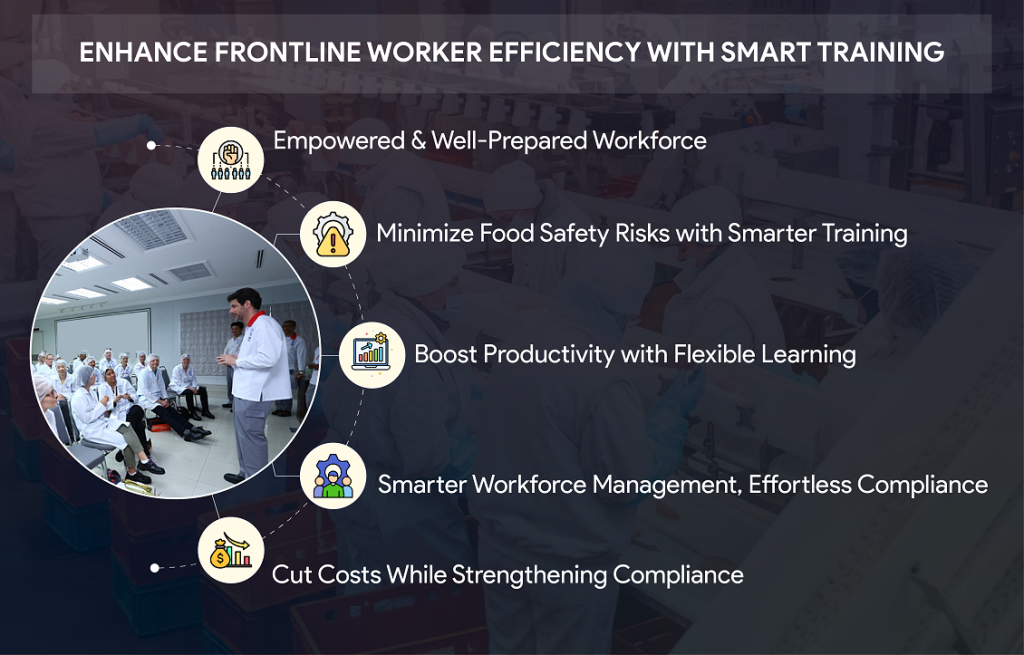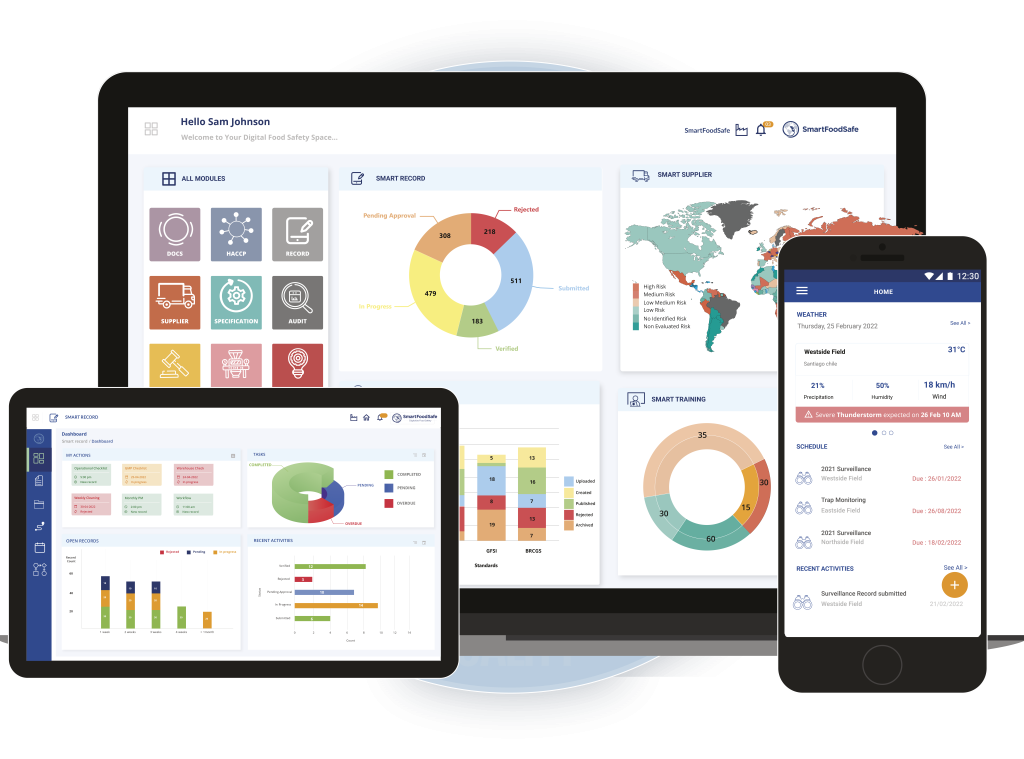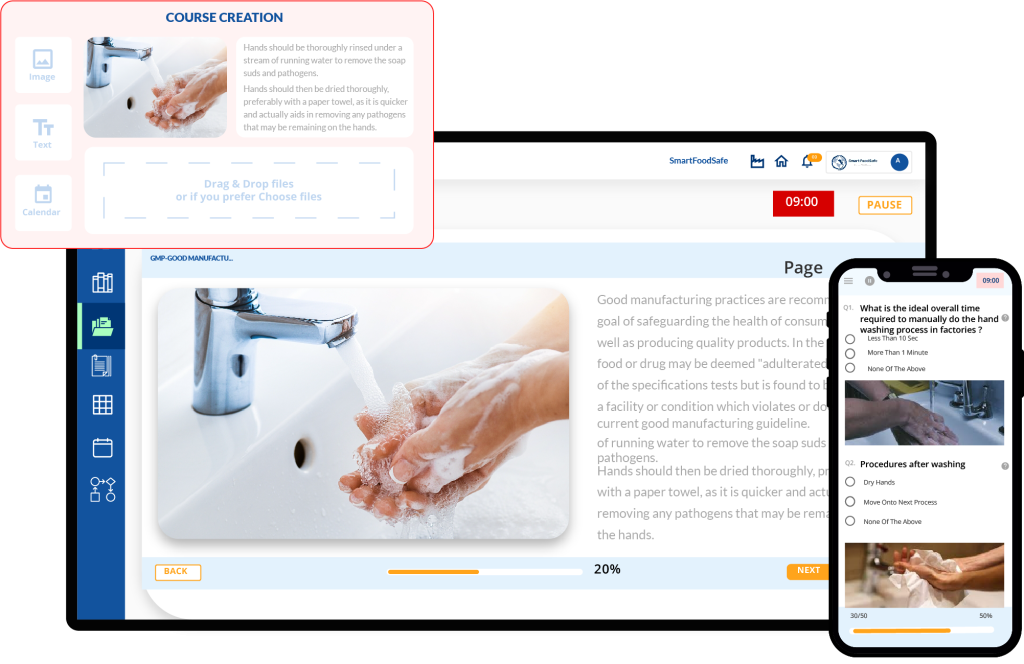


The difference between a good meal and a food safety disaster often lies in the hands of frontline workers. Train them well is the key way to go to protect not just your customers, but your brand’s reputation.
Food handling is a critical aspect of the food and beverage industry, yet it is often overlooked or under-prioritized. With increasing consumer awareness about food safety and hygiene, businesses can no longer afford to treat food handling as an afterthought. The stakes are high—improper food handling can lead to foodborne illnesses, regulatory penalties, and irreversible damage to a brand’s reputation.
The solution? Empowering frontline workers with the right knowledge, skills, and tools to handle food safely and efficiently. Let us see how businesses can train their frontline workers for better food handling practices, and how Smart Training, our innovative training management platform, can elevate this process digitally.
Boost your food business’s hygiene standards with Smart Food Safe’s tech-driven solutions—streamline 4C processes to yield optimal results, and ensure compliance effortlessly.

Boost your food business’s hygiene standards with Smart Food Safe’s tech-driven solutions—streamline 4C processes to yield optimal results, and ensure compliance effortlessly.
The food and beverage industry is built on trust. Customers trust that the food they consume is safe, hygienic, and prepared with care. However, this trust can be shattered in an instant by a single lapse in food handling practices.
Frontline workers—chefs, servers, kitchen staff, and delivery personnel—are the backbone of the food industry. They are the ones who handle, prepare, and serve food daily. Yet, many of them lack adequate training in food safety protocols. Investing in comprehensive food handling training to remediate this gap is truly essential.
As food production, processing, and distribution become more interconnected, contamination risks multiply, making it vital for all food handlers—whether in manufacturing, retail, or food service—to be well-versed in proper hygiene and safety protocols.
Proper training ensures that food handlers understand key safety principles, such as time-temperature control, cross-contamination prevention, allergen management, and proper sanitation, reducing the likelihood of outbreaks and maintaining consumer trust.
Traditional food handling training methods often fall short of delivering the desired results. Here’s why:
These challenges highlight the need for a more innovative, methodical, and engaging approach to food handling training.
Implementing Smart Training isn’t about mindless training sessions on endless courses that end up not serving its purpose, instead, training is made digitally capable to optimize workforce efficiency through smarter learning management processes.
By taking advantage of Smart Training’s features, businesses can establish systematic and simplified training that suits frontline workers’ requirements, equipping them with the knowledge and skills to perform at their best. Here’s how Smart Training enables this:
A knowledgeable workforce is a productive workforce. Smart Training ensures employees gain essential food safety skills through interactive courses, in-course Q&A, and graded assessments that reinforce learning. These features not only improve retention but also ensure employees are confident in applying their knowledge in real-world scenarios.
The certificate generation feature enables businesses to track and certify employee progress, ensuring that frontline staff meet compliance requirements without additional administrative burden.
Preventing foodborne illnesses starts with a well-trained team. Smart Training reduces risks by providing structured and regulatory-aligned training modules that educate employees on the latest food safety standards. Features like refresher settings ensure employees regularly update their knowledge, keeping them sharp and ready to prevent food safety hazards.
With automated scheduling, businesses can seamlessly integrate training into employee workflows, eliminating the need for last-minute compliance catch-ups that could disrupt operations.
Traditional training often results in lost time and operational inefficiencies. Smart Training’s mobile-friendly learning management ability allows employees to complete training in short, manageable sessions without disrupting daily tasks. This approach maximizes learning while minimizing downtime, ensuring continuous operational flow.
The automatic scheduling feature eliminates manual tracking, allowing businesses to plan training around peak business hours, ensuring that learning happens without impacting service levels.
Successful workforce management requires clear visibility into training status and skill levels. Smart Training’s skill matrix and user progress tracking provide managers with real-time insights into employee learning paths. These tools help identify knowledge gaps and ensure that all staff members receive the necessary training to maintain operational excellence.
Moreover, the customized notifications feature keeps employees and managers informed about upcoming training deadlines, reducing the chances of missed certifications or outdated knowledge.
A well-trained workforce not only prevents costly food safety violations but also optimizes training expenses. Smart Training’s data export feature simplifies compliance audits by providing detailed training records, eliminating the need for manual documentation.
Skill gap analysis ensures businesses proactively address training deficiencies before they lead to inefficiencies or costly mistakes. By identifying and filling knowledge gaps early, businesses can maintain a highly capable workforce without excessive training costs.
By aligning advanced training features with operational needs, Smart Training ensures frontline workers are well-equipped, efficient, and compliant.

The difference between a good meal and a food safety disaster often lies in the hands of frontline workers. Train them well is the key way to go to protect not just your customers, but your brand’s reputation.
Food handling is a critical aspect of the food and beverage industry, yet it is often overlooked or under-prioritized. With increasing consumer awareness about food safety and hygiene, businesses can no longer afford to treat food handling as an afterthought. The stakes are high—improper food handling can lead to foodborne illnesses, regulatory penalties, and irreversible damage to a brand’s reputation.
The solution? Empowering frontline workers with the right knowledge, skills, and tools to handle food safely and efficiently. Let us see how businesses can train their frontline workers for better food handling practices, and how Smart Training, our innovative training management platform, can elevate this process digitally.
Boost your food business’s hygiene standards with Smart Food Safe’s tech-driven solutions—streamline 4C processes to yield optimal results, and ensure compliance effortlessly.

The food and beverage industry is built on trust. Customers trust that the food they consume is safe, hygienic, and prepared with care. However, this trust can be shattered in an instant by a single lapse in food handling practices.
Frontline workers—chefs, servers, kitchen staff, and delivery personnel—are the backbone of the food industry. They are the ones who handle, prepare, and serve food daily. Yet, many of them lack adequate training in food safety protocols. Investing in comprehensive food handling training to remediate this gap is truly essential.
As food production, processing, and distribution become more interconnected, contamination risks multiply, making it vital for all food handlers—whether in manufacturing, retail, or food service—to be well-versed in proper hygiene and safety protocols.
Proper training ensures that food handlers understand key safety principles, such as time-temperature control, cross-contamination prevention, allergen management, and proper sanitation, reducing the likelihood of outbreaks and maintaining consumer trust.
Traditional food handling training methods often fall short of delivering the desired results. Here’s why:
These challenges highlight the need for a more innovative, methodical, and engaging approach to food handling training.
Implementing Smart Training isn’t about mindless training sessions on endless courses that end up not serving its purpose, instead, training is made digitally capable to optimize workforce efficiency through smarter learning management processes.
By taking advantage of Smart Training’s features, businesses can establish systematic and simplified training that suits frontline workers’ requirements, equipping them with the knowledge and skills to perform at their best. Here’s how Smart Training enables this:
A knowledgeable workforce is a productive workforce. Smart Training ensures employees gain essential food safety skills through interactive courses, in-course Q&A, and graded assessments that reinforce learning. These features not only improve retention but also ensure employees are confident in applying their knowledge in real-world scenarios.
The certificate generation feature enables businesses to track and certify employee progress, ensuring that frontline staff meet compliance requirements without additional administrative burden.
Preventing foodborne illnesses starts with a well-trained team. Smart Training reduces risks by providing structured and regulatory-aligned training modules that educate employees on the latest food safety standards. Features like refresher settings ensure employees regularly update their knowledge, keeping them sharp and ready to prevent food safety hazards.
With automated scheduling, businesses can seamlessly integrate training into employee workflows, eliminating the need for last-minute compliance catch-ups that could disrupt operations.
Traditional training often results in lost time and operational inefficiencies. Smart Training’s mobile-friendly learning management ability allows employees to complete training in short, manageable sessions without disrupting daily tasks. This approach maximizes learning while minimizing downtime, ensuring continuous operational flow.
The automatic scheduling feature eliminates manual tracking, allowing businesses to plan training around peak business hours, ensuring that learning happens without impacting service levels.
Successful workforce management requires clear visibility into training status and skill levels. Smart Training’s skill matrix and user progress tracking provide managers with real-time insights into employee learning paths. These tools help identify knowledge gaps and ensure that all staff members receive the necessary training to maintain operational excellence.
Moreover, the customized notifications feature keeps employees and managers informed about upcoming training deadlines, reducing the chances of missed certifications or outdated knowledge.
A well-trained workforce not only prevents costly food safety violations but also optimizes training expenses. Smart Training’s data export feature simplifies compliance audits by providing detailed training records, eliminating the need for manual documentation.
Skill gap analysis ensures businesses proactively address training deficiencies before they lead to inefficiencies or costly mistakes. By identifying and filling knowledge gaps early, businesses can maintain a highly capable workforce without excessive training costs.
By aligning advanced training features with operational needs, Smart Training ensures frontline workers are well-equipped, efficient, and compliant.

Signup to receive latest news, insights and updates on training management